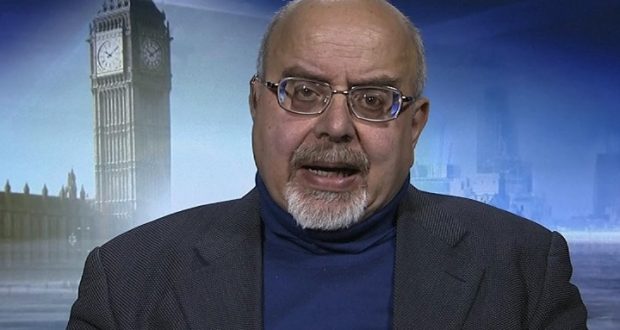سليماني غيّب… فهل يُسمح ببقاء مخططه؟
إياد أبو شقرا/الشرق الأوسط/05 كانون الثاني/2020
Soleimani is Gone, Will his Plan Survive
Eyad Abu Shakra/Asharq Al Awsat/January 09/2020
Qassem Soleimani exiting the Middle East’s arenas is undoubtedly a significant landmark; for the man was able to become a symbol, even a legend, in addition to being the epitome of a project and the face of a conspiracy.
Many of those who were monitoring Soleimani’s ascendancy regarded him as the symbol of the Iranian expansionist imperial dream, which threatens both the existence and identity of the Arab peoples.
Indeed, for decades, he never failed to enhance his symbolism in the Arab world where many worried about his role, while others became henchmen to him and to the authority he represented. As for Iran itself, he was turned into a legend as the importance of the Revolutionary Guards (the IRGC) grew, including the Quds Force led by Soleimani from 1998 until his death a few days ago in Baghdad.
The Quds Force has actually been a fundamental element in the IRGC’s religious – liberation ‘legitimacy’. It has also become a ‘state within a state’ and a money and investment ‘mafia’, beside its role as a ‘special force’ entrusted with brutal suppression in defense of the Wilayat al-Faqih regime.
Here it is worth mentioning that the issue of Al Quds – i.e. Jerusalem – has never been absent from the IRGC’s rhetoric because it is part of the regime’s ‘legitimacy’ as far as external operations are concerned. In other words, the regime’s justifications of occupying other countries and exporting the ‘Khomeinist experiment’. Having said this, one must remember that all the Quds Force’s military activities were never close to Jerusalem; but rather, more interested in shelling Homs, destroying Aleppo, depopulating Zabadani, invading Beirut, and handing over Mosul to ISIS!
Yes, Soleimani became a legend to the younger Iranians, in parallel with the expanding economic and military power of the IRGC, and its increasing control of the political establishment, and its ‘conquests’ in neighboring Arab countries. Incidentally, the IRGC – specifically, the Quds Force – has been the incubator of almost all the sectarian Shiite militias currently active in Iraq, Syria, Lebanon and Yemen.
Moreover, in Gaza, subservience to the IRGC has transcended sectarian divides, as ‘Islamic Jihad’ has become an Iranian arm, and so has a large section of ‘Hamas’. Also in Lebanon (the Resistance Brigades) and Syria (National Defence Forces) militias, which are not exclusively Shiite, were also founded to serve Iran’s project for which Tehran invented the name “Resistance” and sold to the masses.
This “Resistance” which is supposed to mean “Resisting Israel”, has not attacked Israel from south Lebanon since 2006. In Gaza, field hostilities have been nothing but messages exchanged between Tel Aviv and Tehran, and drawing the rules of engagement, without ever reaching the level of “resisting’ occupation let alone a strategy of “liberation”!
Even worse, looking at the way the “Resistance” dealt with the Syrian Revolt it becomes clear that it is based on a plan for Iranian regional hegemony leading, eventually, to a major deal with Israel and Turkey.
It also has to be said that the decision to suppress the uprising of the Syrian people was not taken by Hezbollah in Lebanon, or “Asa’ib Ahl Al-Haq” and “Liwa Abu Al-Fadhl A-Abbas” militias in Iraq; and sure enough not the Afghan Hazara “Liwa Fatemiyoun”, but in Tehran. In the ‘kitchen’ of the Iranian leadership and its IRGC. The systematic suppression and broad collective actions of sectarian militias was by far larger than merely “defending Lebanese-inhabited border villages inside Syria” or protecting Shiite shrines and ‘holy sites’ here and there. They were and are part of a regional map that was drawn with the Khomeinist Revolution and its plans to ‘export’ it.
Even the phenomenon of ISIS which proved to be instrumental in aborting the Syrian Revolt, and the pro-Iran militias’ control over Soleimani’s Arab ‘protectorates’, were in essence different from what the international community – as well as some Arabs – wanted to see.
Violent extremism that imbues some kind of sectarian fundamentalism is not something new; indeed, Arabs and Muslims have known it since Islam’s early days. Furthermore, throughout Islamic history many violent ultra-extremist groups of all creeds and sizes appeared and disappeared.
As for the idea of the ‘Caliphate’ – with ISIS as its latest claimants –, it did not recently emerge from Al-Qaeda or any of the extremist organizations during the last couple of centuries. However, Iran’s relatively recent exploitation of ultra-extremist Islam, in order to serve its own political agenda, has been quite significant.
Tehran has happily co-existed with extremist groups in Afghanistan. This ‘co-existence’, followed by ‘mutual neutralization’, reached high levels of understanding between Tehran and Osama bin Laden; and later between Tehran and Al Qaeda as well as Taliban.
In Syria, it was interesting how the pro-Iran Assad regime ‘co-existed’ with ISIS and its conquests. The Assad regime rarely attempted to bomb ISIS’ stronghold – all vulnerable to air attacks – while ruthlessly bombing civilian neighborhoods in Homs Aleppo, Barada Valley. On the other hand, ISIS spent more time attacking Syrian opposition areas than attacking the positions of the regime, with whom it also concluded oil deals!
The situation was not much different in Iraq. Under the Pro-Iran former Prime Minister Nuri Al-Maliki thousands of Iraqi army troops hurriedly withdrew from the city on Mosul in face of a few hundred ISIS fighters leaving behind brand new army weapons, full bank vaults, and a semi-deserted and broken city, very much in line of Tehran’s policy of uprooting and displacement.
Qassem Soleimani was one of the most important ‘executers’ of this policy of uprooting and displacement, which has nurtured, and later ‘demonized’ Sunni extremism in order to make Shiite extremism look moderate in comparison. Here, we must recall Barack Obama’s description of the Mullahs’ as being “not suicidal”; a belief he interpreted by deserting the Syrian people, ruining Washington’s traditional Arab relations, and betting on Tehran as a future friend and ally.
Today, with Soleimani out of the picture thanks to Donald Trump’s surgical strike, the Middle East must resort to deep thinking rather than jubilation.
What is hoped from Washington, now, is a new and clear strategy towards Tehran’s dangerous regional project, and a serious policy of confrontation rather than mere ‘punishment’ in the forlorn hope that Tehran would change its behavior!
سليماني غيّب… فهل يُسمح ببقاء مخططه؟
إياد أبو شقرا/الشرق الأوسط/05 كانون الثاني/2020
أن يغيب قاسم سليماني عن ساحات الشرق الأوسط فهذا حدث يستحق التوقف عنده. فالرجل، تمكّن لجملة من الأسباب أن يغدو رمزاً وأسطورة، بقدر ما كان عنوان مشروع… ووجه مؤامرة.
كثيرون ممن تابعوا صعود سليماني اعتبروه رمزاً للحلم الإمبراطوري التوسّعي الإيراني الذي يهدّد شعوب المنطقة العربية في وجودها وهويّتها. وحقاً، على امتداد عقود لم يقصّر في تعزيز رمزيته على المستوى العربي، فتخوّف منه كثيرون، بينما استزلمت له وللسلطة التي يمثل قلّة. أما في الداخل الإيراني، فتحول الرمز إلى أسطورة، بالتوازي مع تضخّم أهمية «الحرس الثوري»، بما فيه «فيلق القدس» الذي قاده سليماني منذ عام 1998 حتى مقتله بالأمس في بغداد.
في الواقع، كان «فيلق القدس» ولا يزال عنصراً أساسياً من «الشرعية» التحريرية الدينية لـ«الحرس الثوري» الذي بات «دولة ضمن الدولة» و«مافيا» مال واستثمارات، ناهيك من دوره كـ«قوات خاصة» للقمع الدموي دفاعاً عن نظام الولي الفقيه.
أيضاً لا بد من القول إن مسألة القدس، ما غابت يوماً عن أدبيات «الحرس الثوري»، لأنها جزء من «شرعية» النظام على صعيد العمليات الخارجية… أي تبرير الاحتلالات وتصدير التجربة الخمينية. وهذا، مع تذكّر أن كل العمليات التي خاضها «فيلق القدس» ما اقتربت يوماً من القدس، بل كانت منشغلة في دكّ حمص وتدمير حلب وتهجير الزبداني وغزو بيروت وتسليم الموصل إلى «داعش».
صار سليماني أسطورة عند جيل من الإيرانيين الشباب بالتوازي مع تنامي دور «الحرس الثوري» اقتصادياً وأمنياً، وتشديده قبضته على المؤسسة السياسية، وغزوات «الحرس» التي شنت على الدول العربية المجاورة. ومعلومٌ أن «الحرس الثوري» – خصوصاً «فيلق القدس» – هو الحاضنة الحقيقية لمختلف الميليشيات الطائفية الشيعية الناشطة في كل من العراق ولبنان واليمن وسوريا. بل، في قطاع غزة تجاوزت التبعية لطهران الحاجز المذهبي، فغدت منظمة «الجهاد الإسلامي» ذراعاً إيرانياً، ولحق بها جناح كبير في حركة «حماس».
وأيضاً، في لبنان (سرايا المقاومة) وسوريا (قوات الدفاع الوطني) تشكّلت تنظيمات ليست محض شيعية، تحت مسميات مختلفة، غير أنها تؤدي المهمات نفسها في خدمة المخطط الإيراني الذي ابتكرت له طهران مسمّى «المقاومة» وروّجته وزرعته في عقول البسطاء.
هذه «المقاومة» – المفترض أن المقصود بها «مقاومة إسرائيل» – لم تقاتل إسرائيل من لبنان منذ 2006، أي منذ أكثر من 13 سنة. أما في قطاع غزة، فكانت عمليات القصف بالاتجاهين أقرب إلى توجيه رسائل متبادلة بين تل أبيب وطهران، ورسماً بالسلاح لحدود الاشتباك وسقوفه… ولا تصل بأي حال من الأحوال إلى استراتيجية «مقاومة» احتلال، ناهيك من استراتيجية «تحرير».
أكثر من هذا، تبيّن من الواقع المؤلم، ولدى النظر إلى التعامل مع الثورة السورية، أن مخطط «المقاومة» (أو إيران) يقوم على هيمنة إيرانية إقليمية مطلقة تسفر في نهاية المطاف عن التوصل إلى صفقة كبرى مع إسرائيل وتركيا.
ثم أن قرار قمع ثورة الشعب السوري لم يتخذه «حزب الله» في لبنان، ولا «عصائب أهل الحق» و«لواء أبي الفضل العباس» في العراق، وحتماً ليس لواء «فاطميون» التابع للهزارة الأفغان، بل اتخذ في إيران، ومن قلب مطبخ القيادة الإيرانية وحرسها الثوري. القمع الممنهج والمشاركة الواسعة للميليشيات الطائفية كان أكبر بكثير من حماية قرى لبنانية عبر الحدود السورية، أو مراقد ومزارات هنا وهناك… بل كان جزءاً من خريطة إقليمية ولدت مع ولادة الثورة الخمينية والتخطيط لتصديرها.
حتى ظاهرة «داعش» التي أسهمت إسهاماً مباشراً في إجهاض الثورة السورية، وإحكام ميليشيات طهران طوقها الأمني على «محميات» قاسم سليماني العربية، كان لها وجه آخر غير الوجه الذي رغب المجتمع الدولي – ومنه نحن العرب – أن يكتفي به.
إن التطرّف العنفي الذي يتسم به بعض الغلو المذهبي ليس ابن البارحة، بل عرفه العرب والمسلمون منذ فجر الإسلام. وظهرت عبر التاريخ الإسلامي فرق تكفيرية عنفية من كل الأنواع والأحجام. وفكرة «الخلافة»، التي كان آخر تجلياتها «داعش»، أيضاً لم تولد من رحم «القاعدة» ولا الحركات المتشددة العنفية خلال القرنين الأخيرين. لكن اللافت، هو دور طهران في استغلال الغلوّ المذهبي السنّي واستثماره لخدمتها.
لقد تعايشت طهران بمرور الزمن مع الحالات المتشدّدة في أفغانستان بعدما ابتلعت تجاوزاتها. ووصل «التعايش» و«التحييد المتبادل» إلى مستويات تفاهم مهمة بين طهران وأسامة بن لادن، ثم بينها وبين قياديين أفغان في «القاعدة» و«طالبان». وفي سوريا، كان لافتاً كيف «تعايش» نظام الأسد مع «داعش» وتوسّعه، فأحجم عن اللجوء للقصف الجوي على معاقل التنظيم السابقة كالرقّة وتدمر، بينما كان يقصف مدنيي حلب وحمص ووادي بردى بلا هوادة… وكذلك كيف ركّز «الدواعش» على مهاجمة مناطق سيطرة المعارضة السورية أكثر مما هاجموا معاقل النظام، بل كيف «رتّبوا» أمور تجارة النفط معه!
ولم يختلف الأمر كثيراً عندما تسامح نوري المالكي، صديق نظام طهران في العراق، مع مسألة غزو «داعش» للموصل بقوة عسكرية ضئيلة نسبياً انسحب أمامها ألوف الجنود العراقيين المدجّجين بالسلاح، واعتباره الموصليين – في إحدى المناسبات – «أحفاد يزيد».
وفي النتيجة، استولى «الدواعش» على أسلحة قوات الجيش الفارّة، وموجودات مصارف المدينة، وهجّروا ما استطاعوا تهجيره من أهلها وفق سياسة تهجيرية مطلوبة إيرانياً.
قاسم سليماني كان أحد أهم «منفذي» هذه الاستراتيجية التي غذت ثم «شيّطنت» الغلو السنّي، كي يبدو الغلو الشيعي بالمقارنة معه تياراً معتدلاً «غير انتحاري»، حسب تعبير باراك أوباما. وكما نعرف، توّج الرئيس الأميركي السابق هذه القناعة، بخذلانه السوريين، وتضحيته بعلاقات واشنطن العربية، ورهانه على صداقة طهران والتحالف معها.
اليوم، بعد تغييب سليماني بسلاح دونالد ترمب، على المنطقة التنبه والحذر. المأمول من واشنطن الجديدة صياغة استراتيجية واضحة إزاء خطر مخطط إيران الإقليمي، واعتماد سياسة جادة لمواجهته… وليس فقط «تأديبه» من أجل تغيير سلوكه.
المنطقة تعيش حقبة مصيرية لا تتحمل معها دروساً مجتزأة، والمؤكد أنه لن يفيد الاكتفاء بإرسال التحذيرات والإعراب عن التمنيات وتبنّي الرهانات المتفائلة.






















